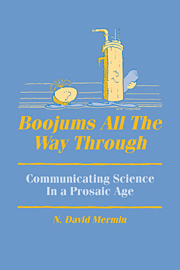Book contents
- Frontmatter
- Contents
- Preface
- I Reflections on the pursuit of physics
- II The quantum theory
- 10 Quantum mysteries for anyone
- 11 Can you help your team tonight by watching on TV?
- 12 Spooky actions at a distance: mysteries of the quantum theory
- 13 A bolt from the blue: the Einstein–Podolsky–Rosen paradox
- 14 The philosophical writings of Niels Bohr
- 15 The great quantum muddle
- 16 What's wrong with this pillow?
- III Relativity
- IV Mathematical musings
11 - Can you help your team tonight by watching on TV?
Published online by Cambridge University Press: 02 December 2009
- Frontmatter
- Contents
- Preface
- I Reflections on the pursuit of physics
- II The quantum theory
- 10 Quantum mysteries for anyone
- 11 Can you help your team tonight by watching on TV?
- 12 Spooky actions at a distance: mysteries of the quantum theory
- 13 A bolt from the blue: the Einstein–Podolsky–Rosen paradox
- 14 The philosophical writings of Niels Bohr
- 15 The great quantum muddle
- 16 What's wrong with this pillow?
- III Relativity
- IV Mathematical musings
Summary
A few years ago I described a simple device that reveals in a very elementary way the extremely perplexing character the data from the Bohm–Einstein–Podolsky–Rosen experiment assumes in the light of the analysis of J. S. Bell. There is a second, closely related form of that gedanken demonstration, which I would like to examine for several reasons.
It is simpler: there are only two (not three) settings for each switch.
The gedanken data resemble more closely the data collected in actual realizations of the device.
None of the possible switch settings produce the perfect correlations found in the first version of the gedanken demonstration, where the lights always flash the same color when the switches have the same setting. Since absolutely perfect correlations are never found in the imperfect experiments we contend with in the real world, an argument that eliminates this feature of the ideal gedanken data can be applied to real data from real experiments. (If you believe, however, along with virtually all physicists, that the quantum theory gives the correct ideal limiting description of all phenomena to which it can be applied, then this is not so important a consideration.)
Because the ideal perfect correlations are absent from this version of the gedanken demonstration, one is no longer impelled to assert the existence of impossible instruction sets. To establish that the new data nevertheless remain peculiar, it is necessary to take a different line of attack, which has again intriguing philosophical implications, but of a rather different character.
The modified demonstration
In the modified gedanken demonstration there are only two switch settings (1 and 2) at each detector.
- Type
- Chapter
- Information
- Boojums All the Way throughCommunicating Science in a Prosaic Age, pp. 95 - 109Publisher: Cambridge University PressPrint publication year: 1990



